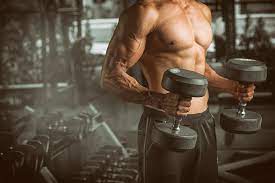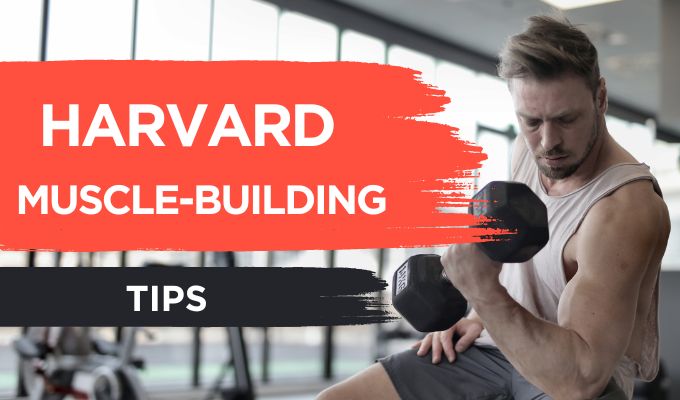Are you tired Harvard’s Muscle-Building Tips? Look no further than the expert advice from Harvard Health. In the quest for a stronger physique, understanding the science behind “Building Better Muscle – Harvard Health” is paramount. Imagine unlocking the secrets endorsed by one of the world’s most esteemed health institutions, paving the way for your muscles to reach new heights. From tailored workout routines to nutritional strategies, Harvard Health provides a comprehensive roadmap to sculpting your dream physique. Get ready to embark on a transformative journey towards building better muscle, backed by Harvard’s trusted insights.

Introduction to Muscle Building:
Muscle building, scientifically known as hypertrophy, is a process that involves the enlargement of muscle fibers through various forms of resistance training. Whether you’re an athlete, fitness enthusiast, or someone looking to improve their overall health, understanding the fundamentals of muscle growth is essential to achieving your goals effectively and safely.
Fundamentals of Muscle Growth:
Muscle growth occurs when muscle fibers undergo stress or damage during resistance training exercises. This stress triggers a series of physiological responses, including the activation of satellite cells, increased protein synthesis, and muscle fiber repair and growth. Consistent training, proper nutrition, and adequate recovery are key factors in maximizing muscle growth.
Effective Training Strategies:
To build muscle effectively, it’s important to incorporate a variety of resistance training exercises targeting different muscle groups. Compound exercises such as squats, deadlifts, and bench presses engage multiple muscle groups simultaneously, promoting overall muscle development. Additionally, incorporating both heavy resistance training for strength and moderate-to-light resistance training for endurance can help stimulate muscle growth and improve muscular strength and endurance.

Optimizing Workouts:
Optimizing your workouts involves finding the right balance between intensity, volume, and frequency. Gradually increasing the intensity and volume of your workouts over time allows for progressive overload, a principle essential for continuous muscle growth. It’s also important to vary your training routine periodically to prevent plateaus and keep your muscles challenged.
Nutrition for Muscle Growth:
Nutrition plays a crucial role in supporting muscle growth and repair. Consuming an adequate amount of protein, ideally spread throughout the day, provides the essential amino acids necessary for muscle protein synthesis. Additionally, carbohydrates serve as a primary energy source during workouts, while fats provide essential fatty acids and support hormone production. Proper hydration is also vital for optimal muscle function and recovery.
Supplementation for Muscle Growth:
While whole foods should always be the foundation of a healthy diet, certain supplements may complement your muscle-building efforts. Whey protein, creatine, and branched-chain amino acids (BCAAs) are commonly used supplements that have been shown to support muscle growth and recovery when combined with proper training and nutrition. However, it’s important to consult with a healthcare professional before starting any supplementation regimen.
Lifestyle Factors Impacting Muscle Growth:
Factors such as sleep, stress management, and recovery practices significantly impact muscle growth and overall health. Aim for 7-9 hours of quality sleep per night to optimize recovery and hormone regulation. Managing stress through relaxation techniques such as meditation or yoga can also support muscle growth by reducing cortisol levels, a hormone associated with muscle breakdown.
Muscle Building for Different Age Groups:
Muscle-building strategies may vary depending on age and individual needs. While younger individuals may focus on maximizing strength and muscle size, older adults should prioritize maintaining muscle mass and function to support overall health and independence. Incorporating resistance training, along with adequate protein intake and lifestyle modifications, can help mitigate age-related muscle loss and improve quality of life.
Integrating Cardiovascular Health with Muscle Building:
While resistance training is essential for muscle growth, cardiovascular exercise is equally important for overall health and fitness. Incorporating activities such as jogging, cycling, or swimming alongside resistance training not only improves cardiovascular health but also enhances muscular endurance and recovery. Aim for a balanced approach that includes both resistance and cardiovascular exercise for optimal results.
Building Muscle on a Budget:
Building muscle doesn’t have to break the bank. Focus on simple, cost-effective options such as bodyweight exercises, resistance bands, or inexpensive home gym equipment like dumbbells and kettlebells. Additionally, prioritize nutrient-dense, budget-friendly foods such as eggs, beans, lentils, and frozen fruits and vegetables to support your muscle-building goals without overspending.

Conclusion:
Building better muscle requires a holistic approach that encompasses proper training, nutrition, supplementation, and lifestyle habits. By understanding the fundamentals of muscle growth and implementing effective strategies tailored to your individual needs, you can optimize your workouts, support muscle development, and improve overall health and well-being. Remember to be patient, stay consistent, and always prioritize safety and sustainability in your muscle-building journey.
FAQS:
Q1:Does gaining muscle improve health?
Yes, gaining muscle can indeed improve health in several ways. Muscle tissue burns more calories at rest compared to fat tissue, so increasing muscle mass can boost metabolism and aid in weight management. Additionally, having more muscle can improve insulin sensitivity, reduce the risk of chronic diseases such as type 2 diabetes and cardiovascular disease, enhance bone density, support better posture and balance, and contribute to overall physical strength and functional capacity.
Q2:What is the healthiest way to build muscle?
The healthiest way to build muscle involves a combination of proper nutrition, adequate rest, and consistent resistance training. It’s essential to consume a balanced diet rich in protein, carbohydrates, healthy fats, vitamins, and minerals to provide the necessary nutrients for muscle growth and repair. Additionally, prioritizing sufficient sleep and rest days is crucial for muscle recovery and optimal performance. When it comes to resistance training, focusing on compound exercises that target multiple muscle groups simultaneously, using proper form, and gradually increasing the intensity and volume of workouts are key components of a healthy muscle-building regimen.
Q3:What is the most effective muscle-building program?
There isn’t a one-size-fits-all answer to the most effective muscle-building program, as individual preferences, goals, and fitness levels vary. However, some common principles of effective muscle-building programs include progressive overload (gradually increasing the resistance or intensity of exercises over time), incorporating a variety of exercises to target different muscle groups, ensuring adequate rest and recovery between workouts, and maintaining consistency with training.
Q4:What are the big 5 muscle building?
The “Big 5” muscle-building exercises typically refer to compound movements that engage multiple muscle groups simultaneously and are considered foundational exercises in strength training:
Squats: A lower-body exercise that primarily targets the quadriceps, hamstrings, glutes, and lower back.
Deadlifts: Another compound exercise that works the posterior chain, including the lower back, glutes, hamstrings, and grip strength.
Bench Press: A chest-focused exercise that also engages the shoulders and triceps.
Overhead Press (or Shoulder Press): Targets the deltoids (shoulders), triceps, and upper chest.
Pull-Ups/Chin-Ups: An upper-body pulling exercise that targets the back, biceps, and should


